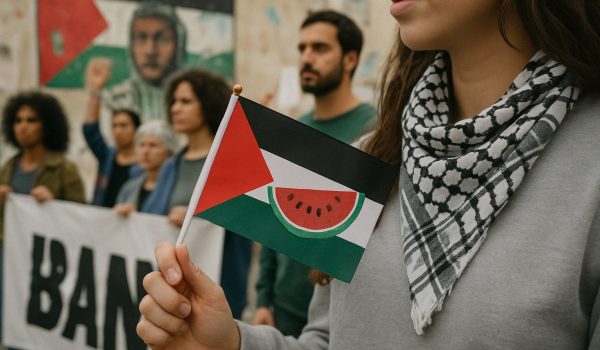Symbols are powerful tools in protest movements. They can carry history, identity, and resistance in a single image. In Palestine, one of the most striking symbols is the watermelon. At first glance, it may seem like an ordinary fruit, but its meaning runs deep. It has become a quiet but strong act of defiance, a way for people to speak when other forms of expression are censored or punished.
The watermelon has the same colors as the Palestinian flag—red, green, white, and black. In situations where the flag has been banned or removed from public spaces, the watermelon offers a creative and peaceful alternative. Artists, protesters, and supporters have used it in murals, graphics, and even emojis to show solidarity and pride.
Why the Watermelon Matters
The use of the watermelon as a symbol dates back to the 1960s and 70s, during a time when showing the Palestinian flag was restricted under Israeli rule. Carrying or displaying the flag could lead to arrest. In response, Palestinians began to use the watermelon in its place. It was a quiet but visible reminder of national identity. A slice of fruit could express what a banned flag could not.
This approach reflected a larger truth about life under occupation. When laws are used to silence, people find other ways to speak. In this case, a fruit from the land itself became a symbol of belonging and resilience. It showed that identity cannot be erased with rules, because it lives in memory, culture, and everyday choices.
Today, the watermelon has returned as a symbol, especially on social media. When images of the flag are censored or removed, people post pictures of watermelons instead. It is a way to outsmart digital filters and keep the message alive. Artists also use it to show pride in Palestinian heritage. In protest posters and street art, it often appears next to olive trees, keys, and other symbols of home.
How the Watermelon Connects to Land and Resistance
The symbolism of the watermelon goes beyond its colors. It also speaks to land, farming, and the connection between people and place. Watermelons are grown in Palestine and have long been a part of the local diet. Families plant them in fields, eat them in the summer, and sell them in markets. Choosing the watermelon as a symbol connects protest not only to culture but to the soil.
This matters in a context where land is central to struggle. Displacement, settlement expansion, and resource control are not abstract ideas—they are daily realities. So when someone holds up a watermelon, they are not just talking about freedom in general. They are talking about staying rooted. They are talking about access to land, water, and a future.
In this way, the watermelon is a deeply local symbol. But it also travels well. Its meaning is easy to understand and visually strong. That has helped it spread beyond Palestine and into the hands of supporters worldwide.
From Streets to Screens
In today’s world, a large part of activism happens online. Social media has changed how people share messages and build communities. It also means that censorship can happen in new ways. Posts about Palestine may be flagged or removed. Certain keywords, images, or hashtags can be hidden from timelines. In these conditions, symbols become especially valuable.
The watermelon is a perfect example. Its colors and shape are easy to recognize. It can be used in paintings, cartoons, stickers, or digital collages. It can even be made into jewelry or printed on clothing. These forms of expression allow people to show support, start conversations, and resist silence.
In recent years, the watermelon has gone viral during moments of tension or protest. Artists post illustrations of watermelon slices instead of using banned hashtags. Supporters share photos of themselves holding the fruit during demonstrations. Even in settings where words are limited, the image speaks clearly.
This visual language helps maintain awareness and unity. It also keeps the message going when platforms try to quiet it. The watermelon has become part of a wider toolkit that includes music, poetry, and storytelling—all ways that Palestinians continue to express their truth.
Watermelon in Art and Culture
Art has always been a space where symbols thrive. The watermelon appears often in Palestinian art as a sign of resistance and identity. Painters use it in murals that cover walls in refugee camps. Graphic designers turn it into powerful logos. Fashion designers include it in prints and embroidery.
Even culinary traditions tie into this. Serving watermelon with salty white cheese, for example, is a common pairing in many Palestinian homes. Sharing this dish becomes a form of cultural expression that connects generations.
By including the watermelon in creative work, artists are not just making something beautiful. They are telling a story of survival. They are taking something familiar and turning it into a message that carries pride, history, and emotion.
More Than a Fruit
The story of the watermelon in Palestinian protest shows how meaning can grow in unexpected places. It’s a reminder that even small acts—like posting a photo or painting a slice of fruit—can carry weight. In situations where large actions are blocked, these symbols allow people to stay connected and heard.
They also build bridges. People outside the region who may not understand all the details of the conflict can still recognize the watermelon and ask questions. This opens space for learning and solidarity. It turns a slice of fruit into a way to say, “I see you. I hear you.”
The watermelon reminds us that protest does not always need to be loud. Sometimes, it is quiet, clever, and rooted in everyday life. It shows how people under pressure can still find joy, color, and strength in their culture. And it proves that symbols, like people, are hard to erase.
When a flag is banned but a watermelon still appears in art, on walls, and in hands, it tells the world something simple but powerful—identity endures.

